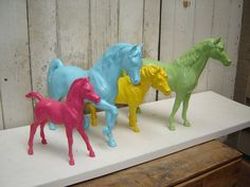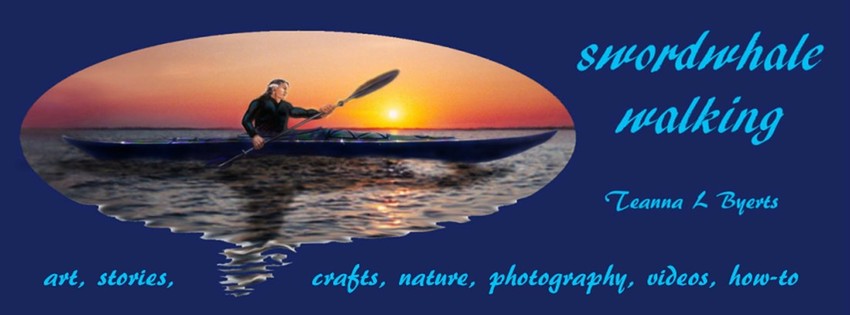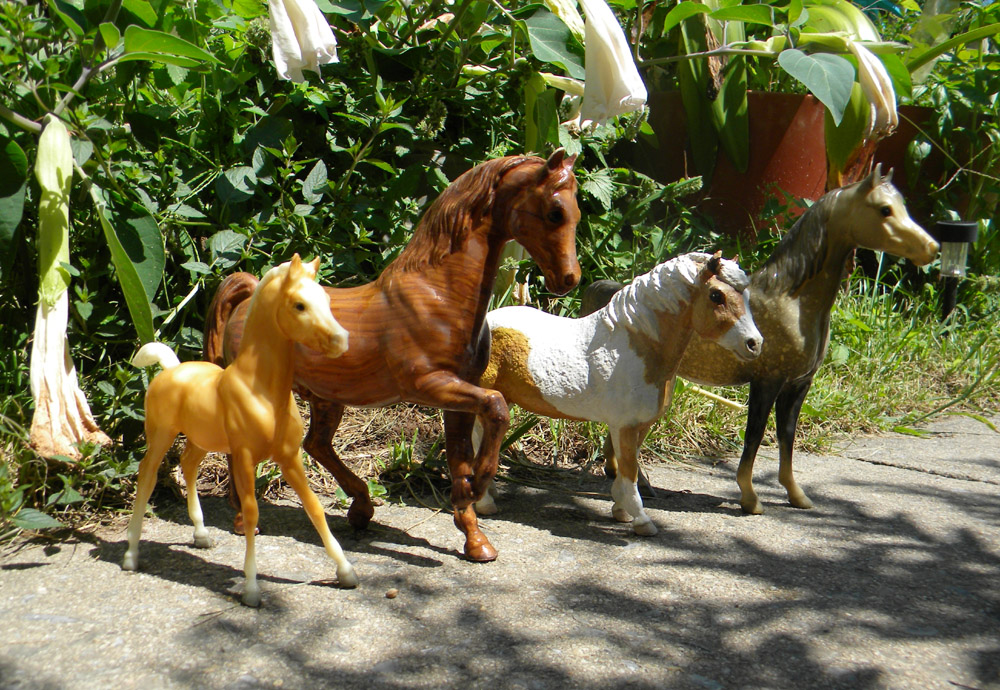more model horses:
Breyer, Gabriel, Johnny West, Schleich, Safari, Hartland and more
Go outside and play with your toys. There's a collection of collectors who do some awesome photography using Breyer and other equine models. Photographing model horses in a landscape makes you look at a familiar place in a new way, interact with a new place in a unique way, and celebrate the artistry of the sculpture that is the model. Also, if you don't have a real horse, this is the next best thing.
Flame, a Johnny West horse (1965-1975ish)
Flame is from my childhood, and is actually one of my favorites. Nice action pose, and fairly accurate anatomy. He came with tack, but I made a lot of my own. The open mouth accommodated a bit, original or homemade. Here I set him up in a snowfall with a doll I found in a thrift shop. She was wearing random clothes and her hair was a mess (so, short bob for you girl!). It took awhile but I finally realized it's Anna from Frozen. She's wonderfully articulated, the exact sort of doll I wished I had as a kid!
Flame sat on shelves for years, and light exposure darkened some areas of his plastic on the left side. You can see the shadows (lighter) of the tack I had on him all that time. It may be time to repaint him.
Flame sat on shelves for years, and light exposure darkened some areas of his plastic on the left side. You can see the shadows (lighter) of the tack I had on him all that time. It may be time to repaint him.
Dallas, a Barbie horse from the early 80s
This pony was also found in a thrift shop. It took some googling but I finally nailed him down as a Barbie horse from the early 80s. Nicely articulated and in good shape, he's not even faded, nor has the plastic changed color from light exposure.
Silver (Gabriel Toys)
Found in a thrift shop badly faded and yellowed without his tack. I repainted him to the actual white horse the Lone Ranger's Silver is supposed to be (the toy was originally designed as a light grey). He's fairly posable and fun to photograph.
Johnny West's "Buckskin"
Another nice "Barbie scale" horse, somewhat poseable. He's actually a palomino (light mane and tail not dark like a buckskin). This is his original paint job. The Johnny West horses were designed by artists who actually knew what horses look like. They echo the type of western horse drawn by Charles Russell and Frederick Remington.
Johnny West's Thunderbolt
A really nice overall model with a terrible original paint job. I'll admit to liking chestnut ("red" genetically, aka sorrel) the least... and black the most of horse colors. The Johnny West chestnuts were flat (shiny helps this color a lot as does variation in color as on a real horse), and the random weird pale spot on the chest was just... random. Perhaps they were trying to evoke the pale undersides/chest/lower legs of "pangare" (think the kind of countershading seen on deer and antelope). Fail! The "blazes" were flaxen, and while a red pinto pony in my pasture has that "donkey nose" mealy muzzle (typical of flaxen and other colors) it shades into the red rather than the hard line here. And blazes are white never flaxen. The stockings have a hard edge, like proper stockings, but are the wrong color: flaxen, not white. Breyer and Hartland had a habit of airbrushing white markings so the edges were blurry. On real horses, white marking edges are sharp. Flaxen chestnuts often have lighter lower legs, a sort of "flaxen stocking" but it shades softly into the darker red farther up. Over all, this was a terrible paint job that I hated. So they became black.
Hartland
Hartland made some nice (if simpler than Breyers) models back in the 60s. This is the Arabian stallion in what they called "alabaster" (near-white grey with a grey mane and tail). The action figure is Legolas from the LOTR collection by Toybiz.
Classic Breyers

In answer to this really gawdawful Pinterest brainfart....
I bring you the Originals...
I bring you the Originals...
Arabian foal, Arabian Stallion (rare woodgrain), Misty of Chincoteague (bought at her gift shop by her stable three months before she died and repainted the correct color pattern), Arabian mare.
Misty of Chincoteague on Chincoteague
I got Misty in 1972, the last year the real Misty was alive. She lived at the Pony Farm on Chincoteague and we visited her there. The gift shop had a Breyer model, painted (oddly for Breyer) completely wrong. Well, at least her head. What Breyer had done was copy the excellent cover art by Wesley Dennis (an awesome artist who knows horses and other animals and has done many many Marguerite Henry books). What they didn't know, was he'd painted the cover as Misty in her foal coat, a misty white with her adult palomino color showing around her eyes. To the non-horseman, it looked like a pinto with a white head and a patch around the eye. her real color was palomino pinto, a solid (as in most tobiano patterns) head with a blaze. I repainted her from photos and Wesley Dennis's paintings of her as an adult. I aquired Stormy a few years later on another trip to Chincoteague. Here they return to their home island.
Below: a collection of Safari models runs along Assateague beach. The lead horse was repainted slightly to look like Surfer Dude, a famous Chincoteague stallion. Spot the mistake? no footprints...
Go ahead, paint it blue
Save your home decor accent-color brainfarts for cheesy Chinese plastic, recycled things found in thrift shops, yard sales and the trash. The larger ones are actually Wonder Horses without their bouncy frames. Their original paint job was awful, their anatomy is great. The mermaid horses are Our Generation: I simply repainted the beat up black one, flat black (with shiny eyes). The battered white one became a blue sea horse (add a ModPodge top layer embedded with glitter for a seawater look). Colors are: Rustoleum 2X Lagoon, Seaside, Oasis and Apple Barrel Craft Paint Turquoise.
Mermaids and Seahorses
Two Our Generation horses (scaled to the American Girl dolls, and much nicer than the AG horses) make a splash...
The whole story here: http://www.swordwhale.com/stupid-gravity-the-adventures-of-a-mermaid-on-eastern-neck-is.html
And here: http://www.swordwhale.com/stupid-gravity-the-search-for-sea-glass.html
The whole story here: http://www.swordwhale.com/stupid-gravity-the-adventures-of-a-mermaid-on-eastern-neck-is.html
And here: http://www.swordwhale.com/stupid-gravity-the-search-for-sea-glass.html
The low waves of this Chesapeake Bay beach are in better scale to the horse than an ocean beach.
Blue Box Toys
Not as detailed as Breyers, these still have a fairly nice shape and reasonably accurate anatomy. Especially nice when repainted, even in basic black. Nice as chalkboard horses, or as resculpt or repaint projects.
Some tips:
- get on your model's eye level for most shots, or on the eye level of the rider.
- try other eye levels: high, low. Set your camera on a beanbag to keep it steady.
- it is sometimes hard to get the whole thing in focus: small models are sharp and backgrounds are fuzzy, or backgrounds are sharp and the model is out of focus. Put the camera on a tripod and take a shot focused on the background, and one focused on the model.
- try throwing in some flying dirt, snow, ice or water
- try throwing stones... really... toss a rock or pebble to make the water splash or snow fly or dirt spatter (try not to knock over your valuable collectibles)
- use sport continuous mode or other mode that takes lots of pics fast, you can do screencaps from a short video clip but the quality isn't as good (smaller file size)
- beware, water has scale (which is how we know that famous photo of the Loch Ness Monster is fake: the lake ripples point out that the model is about three feet tall). Gloppy water that looks like Jello and great big drops of water will show your model to be four inches tall. Play with spray bottles, foamy surf, or other ways to make the water look in scale. Use bigger models and keep the little ones in still water or keep the water in the background.
- keep the ground under the horse's feet in scale: use finer sand/gravel/tanbark, cut that grass, shoot your horse among tiny flowers.
- look for interesting landscapes, your model will make you see them in a new way
- tell a story, have two or more models interact, throw in some effects (flying dirt) to sell the action
- be careful what props you use (tack, dolls, etc) a bad prop will make your horse look fake
- if you are using action figures or articulated dolls, use clothing to hide the joints or Photoshop them out later. Makes it look more real.
- lighting lighting lighting; try different times of day, be careful that you haven't overexposed in sun or underexposed in shade
- where is your sun? your shadow?
- try sunset or sunrise or campfire silhouettes
- on snow or sand make sure you haven't underexposed the horse (do various exposures or use snow/beach mode)
- don't leave your own footprints in that snow or sand!
- try setting the horse in different poses, even a Breyer that isn't articulated can be tilted or leaned, a rearing horse can be set level, your camera angle can change
- normal sized things far away look in scale to your model: if your camera is close to the model, a barn in the far background will look like your horse could go into it
- make a set: a classic bit of film FX is to make a model, (like a building) and shoot it up close while normal sized things are far away (including people walking in the background). Your horse can be set on a piece of board covered with fake ground or grass, a fence to the horse's scale, and normal landscapes and buildings can be in the background and look great.
- don't forget to add your horse's footprints!



